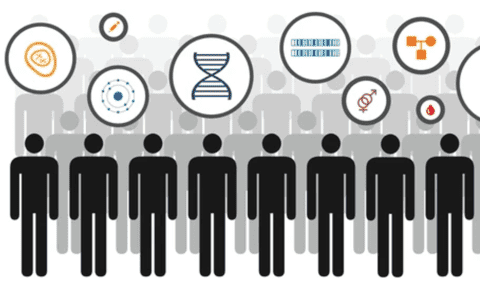Population Genetics: Definition
Population genetics is the study of the genetic makeup of biological populations, as well as the variations in genetic makeup that occur as a result of various factors, such as natural selection Population geneticists, work toward their objectives by creating abstract mathematical models of gene frequency dynamics, attempting to deduce conclusions from those models about the likely patterns of genetic variation in real populations, and then testing those conclusions against empirical data. Below are some of the more robust generalizations that have emerged from the population-genetic analysis.

The study of population genetics is inextricably linked to that of evolution and natural selection, and it is frequently regarded as the theoretical cornerstone of modern Darwinism. Natural selection is one of the most essential variables that can impact the genetic composition of a population. Natural selection occurs when some variants in a population out-produce others because they are better adapted to their environment, or "fitter." If the fitness differences are at least partly due to genetic differences, the genetic makeup of the population will change over time. Population geneticists hope to shed light on the evolutionary process by studying formal models of gene frequency change, allowing the consequences of various evolutionary hypotheses to be investigated quantitatively.
Population Genetics: Example
Mendel’s ‘factors’ are the genes of modern population genetics, and the alleles of a gene are the different forms that an aspect can take (e.g. R versus W in the pea plant example). The reality that each gamete (sex cell) receives only one of each chromosome pair from its parent organism during gametogenesis explains the law of segregation. Other aspects of Mendel’s theory have been revised as new information has become available. Mendel believed that most phenotypic traits, such as seed shape in his pea plants, were controlled by a single pair of genes, but it is now known that most traits are influenced by multiple pairs of genes, not just one. Pairs of factors responsible for different traits like seed shape and flower color do not have to segregate independently. Regardless of these flaws, Mendel’s theory represents a watershed moment in our understanding of inheritance.
Technologies Used in Population Genetics
Allozymes
The development of methods for observing variation in enzyme proteins gave rise to the field of molecular population genetics. The techniques of starch gel electrophoresis and histochemical staining were created primarily to detect variant forms of blood proteins, particularly enzymes, in order to investigate their biochemical function.
PCR-Based Fingerprinting and Genotyping
The invention of the polymerase chain reaction (PCR) revolutionized molecular biology, and with it, organismal and population biology, by spurring new methods to genetic marker screening. DNA fingerprinting is a broad term that encompasses a variety of PCR-based genotyping techniques. A variety of fingerprinting techniques have been developed based on the amplification of random genomic DNA (gDNA) fragments with arbitrary sequence PCR primers. The patterns produced are determined by the PCR primer sequence and the nature of the template DNA.
Microsatellites
Since fingerprinting has limitations, researchers sought alternative methods that were both highly repeatable and allowed for direct scoring of heterozygotes. Microsatellite sequences were discovered to provide such an alternative. Microsatellites, which were first discovered in the myoglobin gene, the zeta-globin pseudogene, and the insulin gene, are tracts with tandem repeats of simple motifs of one to four nucleotides, and the X-gene area of hepatitis B virus.
DNA Sequencing
The ability to determine the sequence of DNA allowed researchers to examine the entire genome. Previously, the target sequence had to be cloned, but this was no longer necessary with the advent of PCR. Organellar genomes were the focus of early DNA sequencing efforts due to their small size. Direct sequencing made mitochondrial DNA screenings much more powerful than RFLP-based screenings, as much more information became accessible.
SNP Genotyping Arrays and High-Throughput Sequencing Methods
Genotyping arrays radically improved our ability to score large numbers of variants at a low cost. When data on a large, fixed panel of SNPs is desired, these methods are still used. With the growth of pyrosequencing technology at the turn of the twenty-first century, high-throughput sequencing began, followed by oligonucleotide ligation sequencing and detection (SOLiD) and Solexa systems.
References:
- Casillas S, Barbadilla A. Molecular Population Genetics (vol 205, pg 1003, 2017). GENETICS. 2019 Oct 1;213(2).
- Charlesworth B. The Origins of Theoretical Population Genetics: How population and quantitative genetics began. TRENDS in Genetics. 2002;6(18).

Leave a Reply